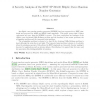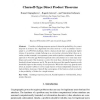114
click to vote
CRYPTO
2007
Springer
15 years 4 months ago
2007
Springer
system is the abstraction of the input-output behavior of any kind of discrete system, in particular cryptographic systems. Many aspects of cryptographic security analyses and pro...
93
Voted
CRYPTO
2007
Springer
15 years 4 months ago
2007
Springer
Oblivious transfer (OT) is an essential building block for secure multiparty computation when there is no honest majority. In this setting, current protocols for n 3 parties requ...
CRYPTO
2007
Springer
15 years 4 months ago
2007
Springer
Abstract. Since Crypto 2004, hash functions have been the target of many attacks which showed that several well-known functions such as SHA-0 or MD5 can no longer be considered sec...
132
click to vote
CRYPTO
2007
Springer
15 years 4 months ago
2007
Springer
We consider the problem of secure identification: user U proves to server S that he knows an agreed (possibly low-entropy) password w, while giving away as little information on w ...
157
Voted
CRYPTO
2007
Springer
15 years 4 months ago
2007
Springer
We present as-strong-as-possible definitions of privacy, and constructions achieving them, for public-key encryption schemes where the encryption algorithm is deterministic. We ob...
95
Voted
CRYPTO
2007
Springer
15 years 6 months ago
2007
Springer
An elliptic curve random number generator (ECRNG) has been approved in a NIST standards and proposed for ANSI and SECG draft standards. This paper proves that, if three conjecture...
101
click to vote
CRYPTO
2007
Springer
15 years 6 months ago
2007
Springer
Abstract. Secure multiparty computation allows a group of distrusting parties to jointly compute a (possibly randomized) function of their inputs. However, it is often the case tha...
115
click to vote
CRYPTO
2007
Springer
15 years 6 months ago
2007
Springer
Consider a challenge-response protocol where the probability of a correct response is at least α for a legitimate user and at most β < α for an attacker. One example is a CAP...
104
click to vote
CRYPTO
2007
Springer
15 years 6 months ago
2007
Springer
One day, you suddenly find that a private key corresponding to your Identity is up for sale at e-Bay. Since you do not suspect a key compromise, perhaps it must be the PKG who is...
119
click to vote
CRYPTO
2007
Springer
15 years 6 months ago
2007
Springer
To date the NTRUEncrypt security parameters have been based on the existence of two types of attack: a meet-in-the-middle attack due to Odlyzko, and a conservative extrapolation of...




